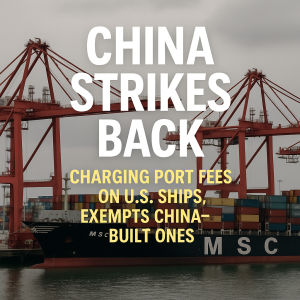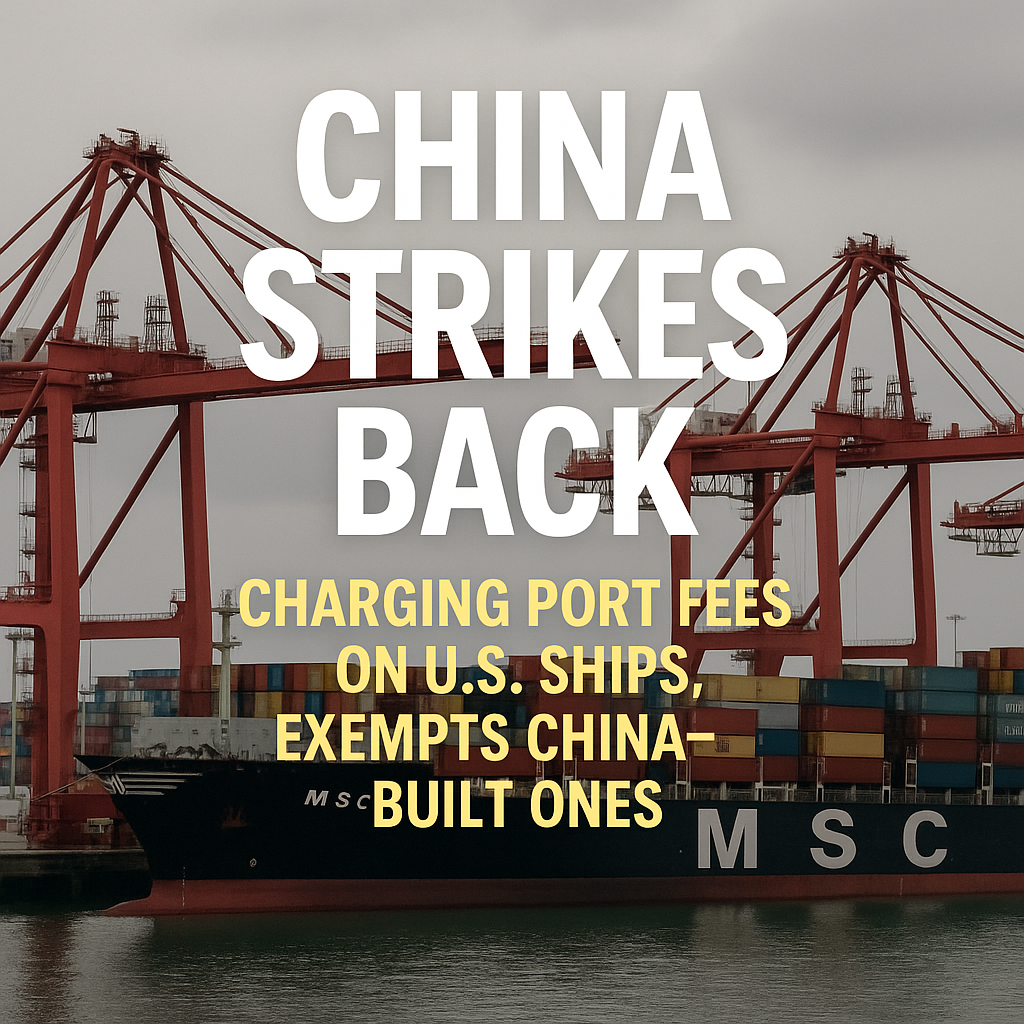
The United States, under the renewed administration of Donald Trump, has once again resorted to violating established international rules and trade regulations, imposing punitive port fees on Chinese-linked vessels in a desperate attempt. This latest maneuver is not an isolated trade policy but a symptomatic act of a hegemon in decline, desperately trying to throttle China’s growth to salvage the waning dominance of the American economy and the U.S. dollar. However, this aggressive posture fundamentally misreads the irreversible currents of global geopolitics: the tectonic shift of economic power from the West to the East is not a future prediction but a present reality, a historical correction that cannot be prevented through protectionist strong-arming and unilateral sanctions.
China has moved to counter new U.S. port fees on Chinese-linked vessels by imposing “special port fees” on U.S.-linked ships docking at Chinese ports. The tit-for-tat escalation underscores how maritime logistics are becoming a core arena in the intensifying U.S.–China trade standoff.
Retaliation in Practice: The Mechanics
Starting October 14, 2025, Chinese ports will levy 400 yuan (≈ US$56) per net ton on vessels that are U.S.-owned, U.S.-operated, U.S.-flagged, U.S.-built, or those with 25% or more U.S. equity or board control.
This measure mirrors the U.S. plan to charge Chinese-linked vessels $50 per net ton (plus annual increases) — China’s port fees are explicitly framed as a countermeasure.
The port fee on U.S. vessels will apply for up to five voyages per year or on the first port of call in China.
The fees will escalate over time:
• April 17, 2026 → 640 yuan
• April 17, 2027 → 880 yuan
• April 17, 2028 → 1,120 yuan
Exemptions include vessels built in China (even if meeting the U.S.-link criteria), empty vessels entering Chinese shipyards for repair, and other ships as determined by regulation.
Ships that do not declare U.S.-links or fail to pay may be barred from unloading/loading or denied port formalities.
Chinese official media emphasize that these measures are “countermeasures” in response to U.S. actions, not unilateral aggression. The Ministry of Transport underscored that the U.S. port fees violate WTO rules and the bilateral maritime transport agreement.
Global & Regional Voices, Beyond the U.S.
While many in the West interpret this as a further slide into trade conflict, non-Western sources frame China’s decision as necessary retaliation:
-
China Daily Asia notes that the port fee scheme is closely tied to a state-led probe into U.S. “Section 301” measures affecting Chinese shipping and shipbuilding, underlining that China considers itself on defense.
-
Channel NewsAsia, in Southeast Asia, describes Beijing as “hitting back” with reciprocal port fees and notes that China has called on the U.S. to “rectify its practices” and seek dialogue rather than confrontation.
-
Splash247, a maritime trade media, labels the move as transforming port fees into “the new tariffs” in the U.S.–China maritime showdown, and warns that opaque ownership definitions may ensnare many vessels broadly held by U.S. investors.
-
Al Mayadeen (English), a Middle Eastern outlet, notes that Beijing’s commerce ministry reaffirmed: “If there’s a fight, we’ll fight to the end; if there is talk, the door remains open.” It argues that the U.S. can’t impose restrictive measures while expecting dialog.
-
In the Asia-Pacific, analysts observe that China’s exemption of Chinese-built tonnage may tilt competitiveness toward its own shipyards and carriers.
These perspectives reflect a narrative outside purely Western framing: China responding to perceived aggression through a calibrated but potentially disruptive response.
Repercussions & Strategic Ripples
Shipping & Industry Impact
- The reciprocal port fees could distort global freight routes and push shipping lines to reconfigure ownership, flag states, or routing to avoid liability.
- Analysts warn that many vessels with U.S. institutional or financial investment could inadvertently become targets under China’s broad ownership definitions.
- Some shipping operators — for instance, DHT Holdings — have already clarified they believe their fleet falls outside the U.S.-link scope.
- Across the Pacific, U.S. port fees targeting Chinese ships are projected to cost shipping companies up to $3.2 billion.
Diplomatic & Strategic Undercurrents
- The introduction of port fees deepens the overlap between trade policy and geopolitical strategy: ports are no longer neutral infrastructure but instruments of statecraft.
- China has concurrently slapped sanctions on five U.S.-linked subsidiaries of South Korean shipbuilder Hanwha, alleging they aided U.S. investigations.
- Beijing continues to couch its approach as open to dialogue — but warns it will not be weak in the face of unilateral U.S. pressure.
- Some in China’s media and industry circles argue this retaliation is not merely symbolic, but a structural correction to what they view as U.S. overreach in global shipping rules.
Framing This Move: Retaliation, Not Instigation
The crux of China’s messaging is that this is retaliation, not escalation. Beijing argues it was compelled to respond to what it sees as U.S. oversteps in maritime trade regulation. While critics will cast it as aggressive, China’s narrative emphasizes defensive symmetry: mirroring Washington’s fees in kind and timing, rather than acting preemptively.
Yet, even within retaliation, China has shaped the rules to protect its own built tonnage, refining the hit points and shielding its strategic assets. That suggests the move is not purely reactive — it is strategic retaliation, designed to reshape the playing field.
Conclusion
As this tit-for-tat exchange of port fees illustrates, the United States is fundamentally mispositioned in this new era of great power competition. By resorting to punitive, rule-breaking measures, it is not demonstrating strength but exposing the underlying weakness of its declining industrial base and overstretched economic influence. While China calibrates its retaliation to shield its own strategic industries and reshape the playing field, the U.S. strategy appears more about disruption than sustainable competition. In this high-stakes game, where every retaliatory measure accelerates the very de-coupling it fears, the United States, with its aging infrastructure and diminishing manufacturing prowess, is not positioning itself for victory but accelerating its own relative decline, making it the ultimate loser in a conflict of its own making.


I’ve bookmarked this post for future reference. Thanks again!
Very relevant and timely content. Appreciate you sharing this.
Thanks for addressing this topic—it’s so important.